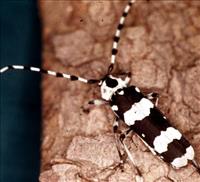
Caption: Banded alder borer
Photo by: Art Antonelli
|
|
Native longhorned beetles (Cerambycids)
(revision date: 8/15/2016)
Use Integrated Pest Management (IPM) for successful pest management.
Biology
Longhorned beetles (roundheaded woodborers) are usually large beetles with long antennae. The body is typically long and cylindrical with parallel sides. The antennae are at least half the length of the body but may be much longer than the body. Most native species feed in recently dead or downed timber, not living trees. Rarely certain species may attack recently cut lumber and can be pests in log cabins, rustic furniture, or other unseasoned wood products. However, these beetles are primarily a nuisance, causing minor or cosmetic damage as the adults emerge from the wood. Adult beetles of some species may be seen feeding on flowers during the day; other species are nocturnal and are attracted to lights at night. They may also enter the house in firewood.
Female beetles lay eggs in cracks in the bark of weakened, dying, dead, or freshly cut or fallen trees. Longhorned beetles infest both softwoods and hardwoods. Larvae are cylindrical, whitish to yellowish and have a rounded head region. They initially feed beneath the bark, then tunnel deeper into the sapwood or even the heartwood as they grow older and larger. It may take months to years for larvae to mature into adults depending on the nutritional and moisture content of the wood. Larval tunnels are round or oval and filled with fibrous, coarsely granular, or powdery frass (feces). Tunnel size depends on beetle species and age of larvae. In some areas, the larvae may be important food sources for woodpeckers and bears. The native longhorned woodboring beetles commonly found in the Pacific Northwest DO NOT attack or reinfest seasoned wood and are NOT considered important structural pests.
One commonly encountered species in the northwest is the banded alder borer. It is a large beetle (1 to 1 ½ inches long) with distinct, dull (not shiny) black and white bands across the body and antennae. The larvae bore in dead trunks of alder, maple, ash, oak, willow, and other tree species. Adults may be attracted to fresh paint. No control measures are necessary for this insect.
Two species of exotic longhorned beetles, the Asian longhorned beetle (Anoplophora glabripennis) and the citrus longhorned beetle (Anoplophora chinensis) will attack living trees and pose a significant threat to landscape, agricultural and lumber tree species. For further information on these exotic pests, please visit the Hortsense website where you will find Exotic longhorned beetles described in the Common Insects and Mites section.
|
|
Management Options
Non-Chemical Management
- Adult beetles found indoors, in firewood, or on screens are harmless. Remove them by sweeping or vacuuming, or capture and release them outdoors.
- Do not store firewood indoors. Bring firewood indoors immediately before use.
- Larvae require certain moisture levels in wood to survive. Use kiln-dried lumber for new construction. Use bark-free, well-seasoned logs for log cabin construction to minimize risk of cosmetic damage by emerging adult beetles. Be cautious when using lumber from salvaged or downed trees.
Select non-chemical management options as your first choice!
Chemical Management
For further information and pictures of native and exotic longhorned beetles, please visit the WSU Puyallup Plant Clinic Pest Leaflet Series at https://puyallup.wsu.edu/plantclinic/pls/. Leaflets with information about longhorned beetles include the following:
•PLS 2, Common Cerambycids of Washington (photos for species comparison)
•PLS 25, Woodboring Pests in Firewood
•PLS 41, Longhorn Beetle Characteristics (photos and descriptions of exotic longhorned beetles)
•PLS 55, Banded Alder Borer
|
